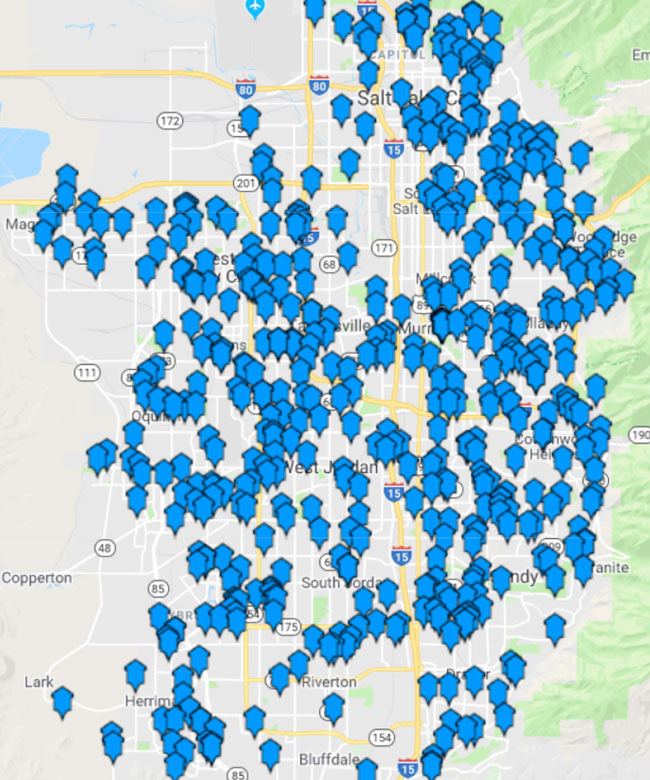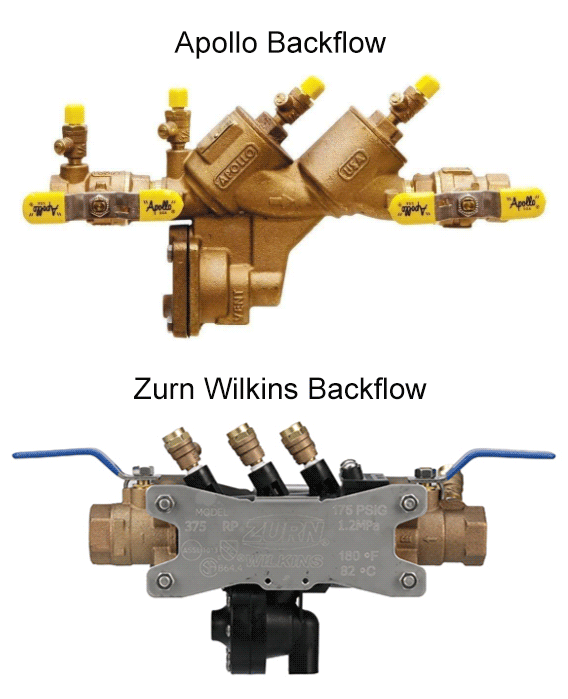

A backflow device prevents water or other material from flowing backward or in an undesirable direction. Backflows are used in many different applications, but we are discussing sprinkler and irrigation backflows. Sprinkler backflows help keep our drinking water clean and uncontaminated because most sprinkler systems in the Salt Lake Valley operate using the same water that we drink (culinary water). A drop in water pressure could lead to fertilizer or other contaminants being drawn into our drinking water, so the backflow prevents this.
While there are many different types and variations of backflows, the two most common backflows that we see in Utah are:

We also see pressure vacuum breakers (PVB) and Watts backflows, but the Zurn and Apollo are the two most common backflows in our area.
While all sprinkler systems that use culinary water should have a backflow installed, not all sprinklers have a backflow. Backflows are usually easy to find if you have one on your sprinkler system because they rise 12 or more inches above the ground. Some backflows are found in irrigation boxes in the ground, similar to where sprinkler valves are located. A sprinkler backflow is usually close to your stop-and-waste or water shutoff and often situated near the house to help protect it from being run over or tripped over. Sometimes people plant bushes or plants in front of them since they are not aesthetically pleasing.
The short answer is yes. If your sprinkler system connects to a culinary water system, you must have an irrigation backflow installed. If you have a sprinkler system connected to secondary water (water that is not for drinking) or well water, you are not required to have a backflow installed on your irrigation system.
While many sprinkler systems have no backflow installed, Utah state law has been requiring them since 1974, so it is a good idea to get one. We have installed and repaired hundreds of irrigation backflows. Repairing or adding a backflow to your sprinkler system can usually be done in a few hours.
There are many reasons a backflow may leak. The most common reason we tend to see in Utah is damage due to freezing. If a backflow is installed correctly, it should be the highest part of your sprinkler system, installed 12-30" above the floor or finished grade. This height makes the sprinkler backflow susceptible to freeze damage because it is exposed to the elements. An early or late season freeze can sometimes be enough to freeze and break your backflow. Ensuring your backflow is insulated correctly or winterized will help prevent freeze damage. Other causes for backflow leaks are when internal parts begin to fail with age or debris becomes lodged in the backflow. Sometimes the debris can be removed, and it stops the leak. Other times backflow parts can become damaged by the debris and need to be replaced.
When Lawn care MVP performs a sprinkler backflow winterization, we do the following:
Since backflows are made mostly of brass, they are expensive. To help save you money, we try to repair backflows before we do a total replacement. It just depends on what is damaged or defective. Our sprinkler techs carry many spare parts with them for the most common Zurn Wilkins backflow, and the most common Apollo backflow. Whether your backflow needs a new ball valve, backflow insert, or complete backflow replacement, we can get your sprinkler system back up and running.
Yes, just about every city in Utah has Cross Connection Control (CCC) staff that may stop by to inspect your sprinkler system for a correctly installed backflow. Some cities are much more proactive with this than others. If you have received a backflow citation, please reach out to us, and we will help bring you up to code.
We stock our sprinkler repair vehicles with an amazing amount of sprinkler parts. This helps ensure that your technician will show up ready to take care of almost any need. However, occasionally we will need to swing by a sprinkler supply store and pick up any additional parts we may need.
We work on any irrigation system, including the following brands; Rain Bird, Hunter, Irritrol, Toro Walla-Walla Sprinkler, Weathermatic, Nelson, Lawn Genie, Orbit, K-Rain, and more.
Every spring comes the time you will need to get your sprinklers turned on and make sure everything is working correctly. Even if you had us winterize your sprinklers for you there is always a chance of issues that arise with sprinkler systems.
Sprinklers are just like anything else we use around the house and unfortunately are not immune from normal wear and tear. A sprinkler head might fill up with water from snowmelt and refreeze causing it to break. Pipes can get pushed or squeezed from tree roots causing breaks or any number of other issues inside the system that can lead to your sprinklers not working correctly come spring.
Some of the things we do when our sprinkler technicians come out to do your Sprinkler Start Up:
We test every valve, every zone, and every head. This service is offered from March-May 1st. Any sprinkler start ups done after May 1st are considered a regular service call and subject to our regular service call rate.
Sprinklers are just like anything else we use around the house and unfortunately are not immune from normal wear and tear. A sprinkler head might fill up with water from snowmelt and refreeze causing it to break. Pipes can get pushed or squeezed from tree roots causing breaks or any number of other issues inside the system that can lead to your sprinklers not working correctly. We work on galvanized, poly, and PVC systems.
Some of our more common repairs include:
Yes, the first appointments of the day can be set. We usually arrive between 7:30 - 8:30 A.M. depending on if we need to stop and pick up parts before we head to your property. We can also arrange to call before we send our repairman to your location. We do respect your time and do everything in our power to get there at a workable time to you.
We don't give free estimates on repairs. On repairs, it is sometimes impossible to know what is wrong until you have dug up or completely repaired what is wrong.
You should be watering your lawn early in the morning, between 3 and 5 AM. Since it’s cooler and sunlight is limited. This gives your lawn a chance to absorb the water before the sun evaporates it.
You don't need to water your lawn every day. Doing so will train the root system to stay closer to the surface where the water is located. Watering deeply, 1-3 times a week, will allow the roots to grow downward in search of water, which in turn makes your lawn more healthy and less vulnerable to drought.
You can also test how hard the lawn is by pushing a screwdriver into your grass. A moist lawn will easily allow the screwdriver through. If it is difficult to press the screwdriver into the ground, it is too dry and needs watering.
Water 2 to 3 times per week.
Water 3 to 4 times per week.